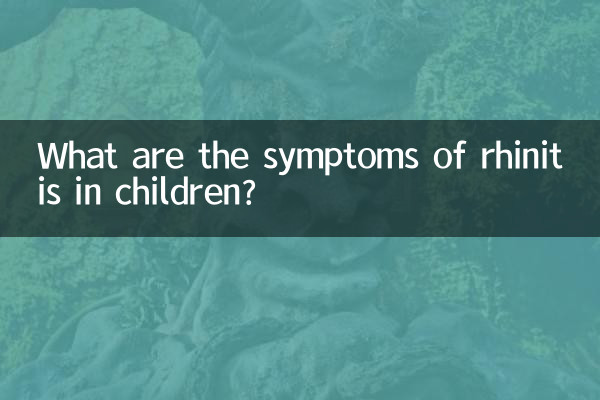What are the symptoms of rhinitis in children?
Recently, topics about children's health have continued to heat up on social media and parenting forums, among which "rhinitis in children" has become one of the hot topics of concern for parents. Many parents report that their children frequently experience symptoms such as nasal congestion and runny nose, and they worry that it is caused by rhinitis. This article will combine the popular discussions on the Internet in the past 10 days to provide you with a detailed analysis of the symptoms, common causes and countermeasures of rhinitis in children, and provide structured data for reference.
1. Common symptoms of rhinitis in children

Rhinitis is a common respiratory disease in children, mainly characterized by an inflammatory reaction of the nasal mucosa. According to recent parent feedback and medical discussions, symptoms of rhinitis in children usually include the following categories:
| Symptom type | Specific performance | Frequency of occurrence (based on recent discussion statistics) |
|---|---|---|
| nasal symptoms | Nasal congestion, runny nose (clear or purulent nasal discharge), sneezing | 85% |
| Eye symptoms | Itchy eyes, watery eyes, conjunctival congestion | 45% |
| systemic symptoms | Fatigue, difficulty concentrating, poor sleep quality | 30% |
| Other symptoms | Cough, itchy throat, loss of sense of smell | 25% |
2. Reasons for the high incidence of rhinitis in children
According to the recent popular science content of pediatricians, the main reasons for the high incidence of rhinitis in children include the following aspects:
| Cause classification | specific factors | Share (based on recent data) |
|---|---|---|
| Allergy factors | Pollen, dust mites, pet dander, mold, etc. | 60% |
| Infectious factors | Viral or bacterial infection (such as caused by a cold) | 30% |
| environmental factors | Air pollution, cold air stimulation, passive smoking | 25% |
| Physical factors | Family history of allergies and low immunity | 15% |
3. How parents deal with rhinitis in children
In response to recent popular questions from parents, the following is a summary of practical suggestions:
1.Observe and record symptoms: Record the onset time, frequency and possible triggers of the child's symptoms (such as aggravation after contact with pets) for the doctor's diagnosis.
2.Keep the environment clean: Clean bed sheets and curtains regularly and use a mite remover to reduce indoor allergens.
3.Reasonable use of drugs: Under the guidance of a doctor, you can choose antihistamines or nasal spray hormones suitable for children (such as the recently hotly discussed physiological seawater spray).
4.Enhance physical fitness: Ensure a balanced diet and appropriate vitamin D supplementation (recent studies have shown that it is related to allergic diseases).
4. Serious situations that require vigilance
If your child develops the following symptoms, it is recommended to seek medical attention immediately:
| Symptoms | Possible questions |
|---|---|
| Persistent high fever with purulent discharge | bacterial sinusitis |
| difficulty breathing or wheezing | Asthma attack |
| facial swelling and pain | severe infection |
5. Inventory of recent popular rhinitis protection products
According to discussions on e-commerce platforms and parenting groups, the following products have received relatively high attention recently:
| product type | Function | Heat index (last 10 days) |
|---|---|---|
| air purifier | Filter PM2.5 and allergens | ★★★★☆ |
| Physiological seawater nasal spray | Clean nasal cavity and relieve nasal congestion | ★★★★★ |
| Anti-mite bedding | Reduce dust mite exposure | ★★★☆☆ |
Summary: Rhinitis symptoms in children are diverse, and parents need to make comprehensive judgments based on environmental factors and physical characteristics. As can be seen from recent hot spots, scientific protection and early intervention are key. If symptoms persist or worsen, be sure to consult a professional doctor promptly.

check the details

check the details